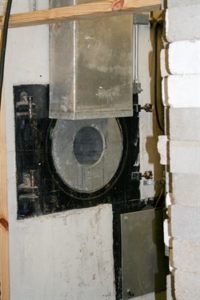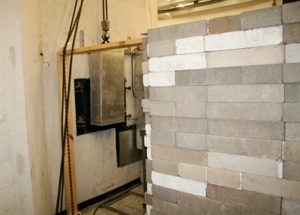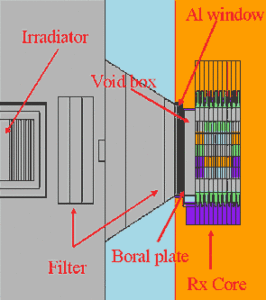Research Capabilities
Nuclear reactors are unique in their ability to deliver a large amount of neutrons to a sample. The most common use of these neutrons is to transmutate a stable isotope into a radioactive isotope either for research, trace elemental analysis, or isotope production purposes.
Another unique property of nuclear reactors is the intense gamma radiation emitted from the core, which is unmatched by most other sources. Many things — from the sterilization of medical tools to the study of radiation effects on electronic components — can be accomplished with gamma radiation.
The Nuclear Engineering & Science Center is a large source of neutrons and gamma radiation, but there are many different options for delivering these types of radiation to a sample.
Neutron Irradiations

Mixed field
Near the reactor, there is a huge gamma flux in addition to the neutron flux. Some of these gammas come directly from fission, while others come from decay products of fission. This mixed field is the most common form of irradiation we use. This means that most of the samples we irradiate are resistant to damage from gamma radiation and from the heat they generate when they interact with matter.
Some researchers wish to expose material to neutrons while minimizing the gamma radiation. Placing a gamma shield (lead) between the reactor and the sample stops most of the gamma radiation with little effect on the neutrons. We have a large irradiation cell to accept almost any size of sample for this purpose.
Past users include the Texas A&M Cyclotron Institute, which used the fields for radiation testing components.

Mixed neutrons for activation

Fission provides neutrons of various energies. Often these energies have different uses. For example, thermal (slow or low-energy) neutrons are best for activation, since most elements prefer absorbing slow neutrons. In the reactor flux, there are more thermal neutrons than fast neutrons, so we can use this flux for most activations.
The primary users of mixed neutron activation are:
- Industrial tracer companies
- Oilfield services companies
- Private research companies that use radioactive metallic parts to test for wear
- Radioactive medical isotopes users
Pure thermal field
The NESC has a heavy water box that will provide a highly thermalized neutron spectrum.
Fast neutron flux
Fast neutrons are preferable to slow neutrons for some jobs, such as argon dating and gemstone irradiation. For these jobs, the NESC has devices that filter out the thermal neutrons, leaving just the fast neutrons. Users include geophysics departments at New Mexico Tech, the University of Minnesota, and the University of Nevada-Las Vegas.
Gamma Irradiations
Reactor gammas
The NESC can use the shutdown reactor to provide intense gamma radiation up to many MRad/hr, neutron-free, in the irradiation cell. If the reactor is operating, neutron-absorbing material can be used to reduce the neutrons without adversely affecting the gamma radiation.
Users include:
- Texas A&M College of Veterinary Medicine
- Texas A&M Department of Horticulture
- Texas A&M Department of Soil and Crop Sciences
Lanthanum source
The NESC has a large lanthanum (La) source that can provide a different energy spectrum than the reactor at lower levels.
Other Services
The NESC provides a place where researchers and industry partners can conduct a variety of experiments with radioactive materials — ideal for organizations without the expertise or licenses necessary to handle and posses these materials. Previous users of these services include various departments at Texas A&M University and several private research institutions.
Neutron activation analysis
The NESC, individually or with the Center for Chemical Characterization and Analysis, uses neutron activation analysis to identify trace metals in various materials.
Previous users of this neutron activation analysis service include:
- Oil field services for quality control
- Semiconductor manufacturers
- Texas A&M Department of Entomology
- Texas A&M Department of Animal Science
- Texas A&M Department of Soil and Crop Sciences
- Texas A&M Department of Oceanography
Radioassay
The NESC houses a counting lab with high-purity germanium detectors. This lab gives us the ability to detect and identify extremely small amounts of radioactive material, ideal for various applications.